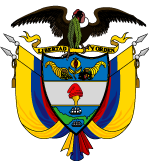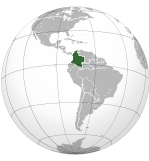Network Access
What are the availability, cost and quality of ICT networks, services and equipment?

1. Information Infrastructure (Stage 3)
Information and Communications Technologies are central to Colombia’s development initiatives. In an effort to increase productivity and drive foreign investments, the Colombian government has expressed a great interest in expanding the availability of broadband Internet service throughout the country.
Until 2003, the only telecommunications operator in Colombia was the state-owned Telecom Colombia. The market has since been opened to competitors and is now home to several Colombian and other Latin-American service providers.
The Ministry of Communications expects that by the end of 2010 the percentage of municipalities with broadband services will be 70% and the number of households with broadband access will be 40%.
Deregulation of the communications sector has helped the infrastructure in Colombia evolve from one of a state controlled monopoly to a more open environment that has brought with it competition and improved affordability.
In 2009, the Colombian government passed legislation that established a framework of policies promoting universal access to information and communications technologies throughout the country. Agencies including the National Spectrum Agency, the Ministry of Information and Communication Technologies, and the Communication Regulatory Commission have been created or re-purposed to oversee Colombia’s evolution and distribution of e-services.
We rate Colombia’s Information Infrastructure as Stage 3. Land line telecom and cable access are limited in rural areas. However, broad access to mobile technologies is present and the government has made a concerted effort to improve availability and quality in coming years.
2. Internet Availability (Stage 3)
As of June 2009 there were 19.2 million Internet users, both dedicated and mobile-access, in Colombia out of a total population of approximately 45 million. This represents an Internet-enabled rate of approximately 44 percent of the population, which is a substantial increase over the 2008 rate of 28 percent. Slightly more than half of all Internet users reside in the major centers of Bogota, Medellin, Cali, and Barranquilla. Colombia is expected to see its IT Markets grow at a rate of 12% annually over each of the next four years.
Mobile Internet represents the largest growth sector in Colombia. Introduced to the country in 1994, mobile telephony has become extremely popular, with a penetration rate of almost 90 percent of the population. As of June 2009, nearly 9 percent of mobile phone users were accessing the Internet via their phones.
We rate Colombia’s Internet availability at Stage 3. Nearly half the population currently has access to the Internet, through either a dedicated connection or mobile device. Connection options are still somewhat limited, though, especially outside major metropolitan areas.
3. Internet Affordability (Stage 2)
There has been an attempt at keeping the cost of ownership of mobile phones down, by placing caps on fees. The same has been done for inter-network connections. Colombia as a whole is plagued by high poverty levels, along with economic inequality. This has greatly impacted the ability of the government to provide services to all rural areas throughout the country.
Earning power in Colombia lags behind much of the developed world. In the widely accepted Big Mac index, which offsets the effects of local prices by measuring the time it takes an average worker to earn enough to afford a Big Mac, workers in Bogota, Colombia have to work 97 minutes to afford the sandwich in comparison to New York City workers at 13 minutes.
We rate Colombia’s Internet affordability at Stage 2. Though efforts are currently underway to reduce regulation and introduce competition amongst service providers, the country is plagued by low purchasing power by its citizens. Even modestly priced Internet connectivity is out of the reach of many of Colombia’s poorer residents.
4. Network Speed and Quality (Stage 2)
Speed of the network is largely dependent on locale. Most urban areas such as Cali, Medellin, and Bogota have access to 3G speeds with very good quality of service. As a whole, the country has slower Internet speeds than developed Western nations; comparable to dial-up. This is especially true in rural areas. Mobile broadband has increased by about 45% from the 2Q 2009 to end 3Q 2009. There was a significant decrease in dial-up subscribers in the same period of about 50%. Traditional high speed connectivity options, such as cable or telephony, are available in major population centers.
We rate Colombia’s network speed and quality as Stage 2. A large proportion of country’s Internet users access via dial-up or mobile phone, options that provide significantly lower bandwidth than dedicated solutions such as cable, DSL, or T-1.
5. Hardware and Software (Stage 3)
The bulk of the ICT equipment currently in use in Colombia is sourced from major suppliers in Israel, Spain, the United States, France, and China.
698,960 computers were imported into Colombia, according to the government, in the first six months of 2009. This number was up slightly, about 2%, from the same period in 2008. This was due mainly to an increase in notebook computer sales, which accounted for more than 50% of total sales. In the long-term, it is expected that growth in the PC segment will be due to lower equipment prices leading to greater affordability. The current shipments of PCs have stalled due to recent peso devaluation.
A software law, currently being worked on by the government, is expected to include measures such as allowing software investments to be amortized and depreciated like other capital investments. This should lead to an increase in capital spending by local businesses and an eventual modernization of the country’s software infrastructure.
The majority of the near-term software demand is expected to be for such applications as enterprise risk management (ERM) and supply chain management systems.
We rate Colombia’s Hardware and Software as Stage 3. Most of the communications equipment currently in use has been sourced from abroad and complies with all major international standards. There is a growing base of PC users and availability of technology is improving.
6. Service and Support (Stage 2)
There are very few Internet Service Providers in Colombia. Some offer a wide array of solutions for business including VOIP phone options.
Currently, the mobile service providers operating in Colombia are Comcel, which is owned by American Movil based in Mexico, Telefonica Movistar which is part of Telefonica from Spain, and Colombia Movil part of Millicom International Cellular. Their market shares are 67%, 22%, and 10% respectively...
Colombia’s Internet Service and Support is rated as Stage 2. There are a limited number of service providers and remote regions are poorly serviced.
 Colombia’s Networked Readiness
Colombia’s Networked Readiness